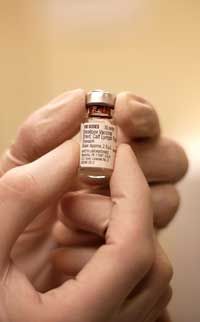Rare diseases are difficult to classify because of their very nature. For our purposes, we've listed examples of the rarest diseases that exist only in laboratories, affect a handful of people or are virtually impossible to contract.
Smallpox
You might not expect one of the world's rarest diseases to be something that has killed millions of people throughout human history. But, if you wanted to catch a case of smallpox, the only sure place to find it would be in a handful of government laboratories.
Smallpox is spread by the variola virus, which causes fever, body aches, and a rash that quickly develops into fluid-filled bumps. These bumps scab and eventually form permanent, pitted scars. The disease spreads chiefly through direct contact with an infected person's skin or body fluids, but can also spread though the air in close, confined environments. The most common form of the disease boasts a 30 percent mortality rate [source: Centers for Disease Control].
However, thanks to the development of a vaccine and the World Health Organization's 1967 eradication campaign, death from smallpox is unheard of today. The last naturally occurring case of the smallpox epidemic was in 1977, and since then only a handful of laboratory accidents have resulted in infections.
Fields Condition
If you have a genetic disease that's really rare, then doctors probably will name it after you. That's exactly what happened to British twins Catherine and Kirstie Fields. The pair were born with a previously undiagnosed neuromuscular disease now known as Fields condition. The disease affects the nerves that cause voluntary muscle movements. As a result, the Fields twins spend much of their time in wheelchairs and have difficulty performing delicate tasks, such as writing.
Scientists are still studying Fields condition, but the twins could conceivably pass the condition to their future offspring. Additional diagnoses may be made as knowledge of the condition grows, and more unrelated cases could develop over time.
While Fields condition may become more widespread, what about rare diseases that show little sign of surviving on their own? One such disease is Kuru.
Kuru
The average person's chances of contracting or developing Kuru are virtually nonexistent. To catch this fatal neurological disease, you'd have to travel to a remote region in the highlands of New Guinea, find one of the few remaining carriers of the disease, and eat his or her brains.
Kuru belongs to a rare breed of disorders caused by prions. These abnormal proteins induce irregular protein folding in brain cells. This construction technique leads to flawed brain tissue, resulting in progressive and incurable brain damage. The word kuru means "laughing disease," so named because scientists observed fits of hysterical laughing by those affected.
Similar prion conditions, such as Creutzfeldt-Jakob disease (the human variant of mad cow disease) are more common. Kuru only occurs in New Guinea's isolated Fore tribe. The condition first emerged in the 1950s and quickly decimated whole villages. Scientists quickly discovered that the only way to acquire the disease was through the consumption of contaminated brain tissue. The Fore followed cannibalistic funeral rites that required them to cook and eat the dead -- a practice they believed passed on spiritual aspects of the dead to the living. Closely related females and children consumed the brain and contracted the deadly kuru.
When Westerners abolished cannibalism in the region, new incidents of the disease disappeared nearly overnight. Scientists haven't discovered new cases of kuru in any Fore tribesperson born after the late 1950s.
Having a rare disease is half the battle -- you must rely on educated medical professionals to diagnose your condition and help you find treatment. Read on to find out how doctors treat patients with rare diseases.



